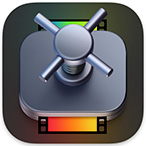 Apple Compressor is a stand-alone, Mac-based program that compresses audio and video into a variety of formats for distribution. Long derided for its slow speed and poor image quality, since the release of Apple silicon Macs, upgrades have dramatically improved its speed and quality. As well, its interface simplifies compressing media, while providing access to lots of customization under the surface.
Apple Compressor is a stand-alone, Mac-based program that compresses audio and video into a variety of formats for distribution. Long derided for its slow speed and poor image quality, since the release of Apple silicon Macs, upgrades have dramatically improved its speed and quality. As well, its interface simplifies compressing media, while providing access to lots of customization under the surface.
While it doesn’t support Windows-only media formats, it does support a wide-range of media, including all formats required for social media or web distribution.
As well, it performs a number of tasks that most other compression software doesn’t, including:
Finally, because Compressor is stand-alone, any Mac user can use it to compress media, owning Apple Final Cut Pro is not required. Compressor costs $50 (US), so adding Compressor won’t overwhelm your budget.
WHY USE COMPRESSOR?
I use Compressor as a media converter, to do tasks that Final Cut or Premiere can’t easily do. For example:
While Adobe Media Encoder is faster on Intel systems, Apple Compressor is faster on M-series Macs, especially when working with ProRes source files.
NOTE: Here’s a detailed test review between Compressor, Adobe Media Encoder and ffWorks/ffMPEG, comparing Intel and Apple silicon systems.
THE BASIC WORKFLOW
Here are the basic steps to compressing media:
To make this process even simpler, you can create custom compression settings, along with default destinations and file names, so that the process in most cases is:
BASIC OPERATION
This screen appears when you first open Compressor.
Drag one or more files from the Finder into the lower-center of the interface. The files appear in the Batch list (Milford Sound, in my example).

If the Settings options are not visible, click the Settings icon in the top left (top red arrow).
While you could use the YouTube/Facebook settings, I recommend you look further down the list to Video Sharing Services. This option works well for all social media.

Drag the setting that corresponds to the size of your media (most frequently “HD 1080p”) on to top of the name of the file you want to compress in the Batch List. Or, select all files (Cmd + A) and apply the same setting to all of them at once.
NOTE: You know you dragged it to the right spot, if the name bar turns white (top image).

To change the storage location of the compressed file, right-click the default name, “Source”, and select either one of the three default options or click “Other” to select another location.
NOTE: This default can be changed – see below.

By default, the compressed file name has the same name as the source file with the compression setting name appended to it. If necessary, click the file name and change it.
NOTE: This default can be changed – see below.

To modify a compression setting, select the setting attached to a clip and open the Inspector by clicking the icon in the top right corner (top red arrow).
NOTE: The settings in “Video Sharing Services” are optimized for posting clips online, so you don’t really need to change anything.
However, explore these three setting panels so you can see what’s there.

I’ve written over 200 tutorials on Compressor, so there’s lots this app can do. To see what I’ve written, go to LarryJordan.com/free-tutorials and select Compressor from the Applications search menu (red arrow).
Apple’s Help files are available as well.
![]()
To start compression, click Start Batch at the bottom right of the Batch panel.
FINISH THE PROCESS
As soon as you click Start Batch, the interface switches to the Active panel so you can track the status of jobs.
NOTE: There’s no real limit to the number of files you can compress in the same batch. I’ve done 50 with no problems.

When a task is complete, you can see the details in the Completed panel. Here, Compressor took 12 seconds to compress a 46-second, 4K ProRes 422 file.
CUSTOMIZING PREFERENCES

To change the default compression or location setting, go to Compressor > Settings > General.

To create a custom storage location, go to the Locations panel (top red arrow), then click the Plus icon at the bottom (bottom red arrow).

To create a custom compression setting, right-click the setting you want to modify and choose Duplicate.
The copy appears in the CUSTOM settings at the bottom. Select the setting you want to modify in the CUSTOM section, then change settings as necessary in the Inspector.
All these customization settings are saved automatically.
4 Responses to The Basics of Using Apple Compressor
Have they fixed their Blu-ray problem not playable on stand-alone players?
Richard:
I don’t have a way to test this, so I don’t have an answer. My guess, though, is not.
Larry
I have hundreds of video files captured in mxf RAW format, which will not open in FCPX. I can convert those files into ProRes using Sony’s RAW Viewer, but it’s kind of a laborious and slow procedure. I’m wondering if Apple Compressor could do that transcoding, and if it would be at a reasonable pace?
And my thanks to you also. Your newsletter has been for me a most invaluable source of how-to-do-it for quite of few years now.
Fake:
First, thanks for your kind words.
In answer to your question, I’m not sure. MZF RAW is not a format I’ve worked with. Compressor does handle some MCF formats, but I’m not sure about RAW.
Compressor costs $50 so it’s not terribly expensive. But before you buy it check into Handbrake. That may do the job and cost less.
Larry